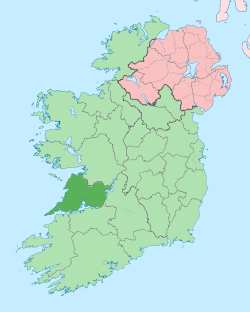Quin, County Clare
| Quin Cuinche | |
|---|---|
| Village and parish | |
|
The ruins of the former parish church, with Quin Abbey beyond | |
 Quin Location in Ireland | |
| Coordinates: 52°49′06″N 8°51′55″W / 52.8183°N 8.865358°W | |
| Country | Ireland |
| Province | Munster |
| County | County Clare |
| Local electoral area | Ennis East |
| Dáil Éireann Constituency | Clare |
| Elevation | 17 m (56 ft) |
| Population (2006) | |
| • Urban | 565 |
| • Rural | 1,050 |
| Time zone | WET (UTC+0) |
| • Summer (DST) | IST (WEST) (UTC-1) |
| Irish Grid Reference | R417742 |
Quin (Irish: Cuinche, meaning "five ways") is a village in southeast County Clare in Ireland and a Catholic parish and civil parish of the same name. The main attraction, Quin Abbey, is open to the public, and although mostly ruined, much of the structure remains. The abbey was built on the foundations of an earlier Norman castle, and the foundations of its corner towers can still be seen. The name of the village is a reference in ancient Irish to the original five roads out of the village.
Location
The parish of Quin is in the Bunratty Upper barony.[1] It is 5.5 miles (8.9 km) from Ennis. The parish held 7,290 statute acres in 1837, as applotted under the tithe act. There was a productive lead mine at Ballyhickey. The ore was taken to Clarecastle for shipment to Wales. The River Rine runs through the village of Quin. Knappogue Castle is two miles from the village. Quin abbey is considered to be one of the finest and most complete remains of monastic antiquity in Ireland. In 1837 the parish had a small plain church of the Church of Ireland, built in 1797. A new Catholic chapel was being built in Gothic style.[2]
The parish is in the Roman Catholic Diocese of Killaloe. Churches are the Blessed John XXIII in Clooney, St Mary's in Quin and St Stephen's in Maghera,[3]
Townlands are Applefort, Ballagh, Ballyhannan North, Ballyhannan South, Ballykilty, Ballymacloon East, Ballymacloon North, Ballymacloon West, Ballymarkahan, Ballyroughan North, Ballyroughan South, Cahercalla, Cant, Carnmallow, Carrowgar, Carrowmeer, Carrowroe, Cloonaherna, Coogaun, Coolshamroge, Commons, Cragbwee, Craggataska, Craggaunowen, Creevagh Beg, Creevagh More, Cullenagh, Cullaun, Cutteen, Dangan, Danganbrack, Deerpark North, Deerpark South, Feaghquin, Gorteen, Keevagh, Kildrum, Kilnacrandy, Knocknagoug, Knappogue, Madara, Quin, Quingardens, Quinville North, Quinville South, Rathluby, Rine, Rinneen and Shandangan.[4]
History
Some of the most important Prehistoric Gold works in Ireland were found in Quin.
The countryside around the village of Quin has many archaeological remains, most notably the Franciscan friary. An abbey was founded in Quin around 1250, but was burned down in 1278. De Clare built a castle in 1280 A.D. This was attacked and destroyed, the present church was built on the site (c.1350 A.D.), incorporating some parts of the castle ruins. Quin is first mentioned as a village in the days of the Norman Castle which preceded the Abbey. Quin Abbey was founded in 1433 and housed many Franciscan monks until 1820 when the last monk, Father Hogan, died. His Burial Site can be visited in the Abbey. News of the Great Rebellion of 1641 was first announced in Co. Clare "at the great fair of Quin", which must have been a big event in the county of those days.
Demographics
As of 1831 there were 2,918 inhabitants, of whom 173 lived in the village.[2] According to a 2002 Census, Quin had a population of 853. By 2006, the population had grown to around 1,048. In the 2011 census the population had increased to 1,454.[5]
Sport
Clooney Quin GAA was founded in 1888. Clooney/Quin's most famous player was Amby Power, who captained the Clare 1914 All-Ireland winning team.[6]
Notable people
- Ger Colleran, former editor of the Irish Daily Star, grew up in Quin
- Paddy Hannan born in 1840, started the then world's biggest gold rush in 1893 in Kalgoorlie
- Amby Power, born in 1887 in Quin, was a hurler
- Arthur Quinlan was reared in Quin[7]
See also
References
- ↑ "Quin". Parliamentary Gazeteer of Ireland. 1845. Retrieved 2014-04-01.
- 1 2 Samuel Lewis (1837). "Quin". County Clare: A History and Topography. Retrieved 2014-04-01.
- ↑ "Quin Churches". Diocese of Killaloe. Retrieved 2014-04-01.
- ↑ "Map of Quin Parish showing Townlands". Clare County Library. Retrieved 2014-04-01.
- ↑ "The Clare Champion Newspaper". Clarechampion.ie. Retrieved 2014-02-09.
- ↑ "Clooney Quin GAA Club - History of the Club". Clooneyquingaa.ie. Retrieved 2014-02-09.
- ↑ "Journalist Arthur Quinlan dies aged 92". RTÉ News. 23 December 2012. Retrieved 23 December 2012.
External links
| Wikimedia Commons has media related to Quin, County Clare. |
Coordinates: 52°49′5.88″N 8°51′55.29″W / 52.8183000°N 8.8653583°W

